#Wankel Engine
Explore tagged Tumblr posts
Note
What's an automotive technology that you wish had made it that didn't?





NSU Trapeze, 1973, by Bertone. In the late 60s and early 70s it seemed likely the rotary engine, invented by Felix Wankel, was going to take over the auto industry. The advantages of compact design, smoothness, low weight, and fewer parts over piston internal combustion engines gave rotary power a bright future. NSU was the first car company to develop the Wankel motor into series production but from the late 60s all major automobile makers were working on rotary power, perhaps most famously General Motors and of course Mazda. Alas as is often the case physics got in the way, despite its remarkable power the Wankel system has lower thermal efficiency and higher emissions relative to a piston engine. So from the early 70s one by one everyone abandoned their rotary programs apart from the Volkswagen AG (by now owners of NSU), Citroën and Mazda. Not only was Bertone's Trapeze rotary-powered but it also presents another configuration concept that seemed to have potential in the 70s and early 80s. Mid-engined 4/5 seat cars. A number of concepts were presented with 2 and 4 doors that could seat multiple passengers with engines placed behind the rear seats (in the Trapeze it was in the middle of them). However no-one ever got around to putting a mid-engine 4-door saloon into production and the industry moved onto almost universal adoption of front transverse engines and front wheel drive.
Fun fact about Felix Wankel (1902-1988) inventor of the rotary engine, he was extremely nearsighted and never held a driver’s licence but had the same chauffeur for most of his life
rotary gif by Y_tambe
#NSU#NSU Trapeze#Bertone#Bertone Trapeze#concept#mid-engine#rotary engine#Wankel engine#twin rotor#dead brands#4-seater#question#answer
194 notes
·
View notes
Text
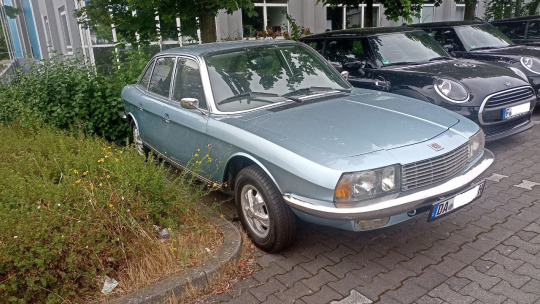
Saw this rare classic today on my lunch break. A NSU Ro 80, a Wankel engine powered sedan that was build between 1967 and 1977.
23 notes
·
View notes
Text
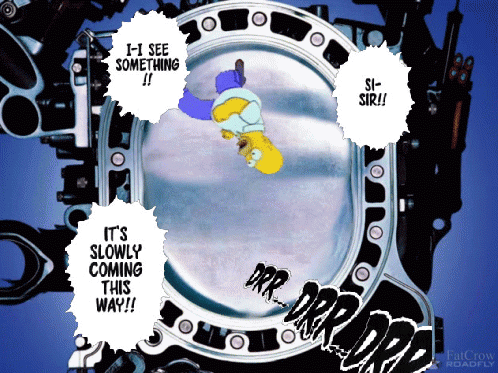
Now i know how a wankel engine works.
#unstaged-file#the simpsons#homer#homer simpson#wankel engine#rotary engine#rotary#rx7#mazda#junji ito#the enigma of amigara fault
22 notes
·
View notes
Text

Fig. 6-8. Zwauer-Wankel diagram of a Displacer-free rotary Stirling engine.
1 - expansion unit; 2 - heater tubes; 3 - cavity; 4 - combustion zone; 7 - shaft; 6 - compression unit-cavity; 8 - water-cooled heat exchanger; 9 - regenerator.
0 notes
Text
They could never make me hate you, Wankel engine


#wankel engine#3 stroke motor#motor#engine#i love you wankel motor i will think about you until i forget you again
1 note
·
View note
Text
Most definitely the most particular thing about the RX-7 (and about every RX- before and after it) is the technology it owes its name to: the Rotary Xngine. You know what, maybe the X doesn't stand for engine.
You see, such sportscars usually have 4 cylinders at the least and 8 at the most. This one has 0. That's because in Wankel engines the combustion happens in rotors, Reauleaux triangle-shaped metal thingys that, in their spinning around, compress the air/fuel mixture which in return, once ignited, pushes the rotors.

BENEFITS As you can see, this cycle happens on every side of the rotor, so it's a bit like every rotor equated to three cylinders - so they pack some enormous punch for the engine size: this here RX-7 has a positively minuscule 1.2L engine (which means insurance is cheeeeeeap). The engine is also so smooth they had to add a buzzer so you realized you were revving the tits off of the thing - which you also could do because it revved real high. It also tends to sound glorious. What's not to love? Well...
DRAWBACKS You know when I said "air/fuel mixture"? Yeah, it's more like "air/fuel/oil mixture", because unlike in a cylinder engine, where you can have the mixture in one part of the combustion chamber and the oil to lubricate the piston's travel in the other, here every part of the combustion chamber has fuel mixture in it, so the only way to lubricate it is to add oil to the mixture. Usually when your car burns oil you take it up with the mechanic - here you'll have to take it up with Mr. Wankel (and if you do, let's just say you might want to avoid being a jew). Reliability-wise it goes from "spoiled" to "nightmare" depending on who you ask, fuel consumption is pretty bad, and while they have quite the power they lack a bit in torque, making them not ideal for low-RPM weight pulling applications like gargantuan sedans, pickups or buses. (Not that it stopped Mazda from using it in all three, but hey, is there anyone we'd like more if they always did what's wisest?)



And still, beloved the Mazda rotary is (other makers dabbled in 'em but Mazda was the only one to stick with them long term, shoving them into production cars up to 2012), and beloved the RX- sportscars are, hence the two being frequent subjects of engine swaps.
ENGINE SWAPS An engine swap is the act of chucking the engine out your car and putting in a different one - more powerful, more reliable, cheaper to maintain, better sounding (yes that's a factor to many people) or what have you. And indeed, there are a handful of engines that are very popular to swap into cars (usually due to popularity in the aftermarket, a desirable trait when looking for someone who makes some random bit for when that engine is put in your car) and some cars it's very popular to swap engines into (usually for a mix of the above and the rest of the car being better than its engine).
Mazda's rotary engines are in the unique spot of both being popular engines to swap into cars -as compact, lightweight, powerful engines with an aftermarket scene happy to supply you parts to push them into four digits of horsepower- and popular engines to swap out of cars -usually in favor of the LS V8 engine, on the opposite end of the sportscar engine reliability and fussiness spectrum. That swap, however, is kind of controversial, as the rotary engine is pretty much seen as 'the point' of Mazda's RX series of sportscars and a big honkin' V8 is seen as the antithesis to that point. Kind of like making an avocado toast but replacing the avocado with beef.
CONCLUSION You didn't tell me I had to write a conclusion. I have nothing else to say
YOU CAN JUST SAY BYE Ok then. Bye!
Links in blue are posts of mine explaining the words in question - if you liked this post, you might like those!

#mazda rx-7#mazda REPU#mazda roadpacer AP#mazda uhhh. what the hell was it#parkway!#mazda parkway#rotary engine#wankel engine#engine swap
313 notes
·
View notes
Text

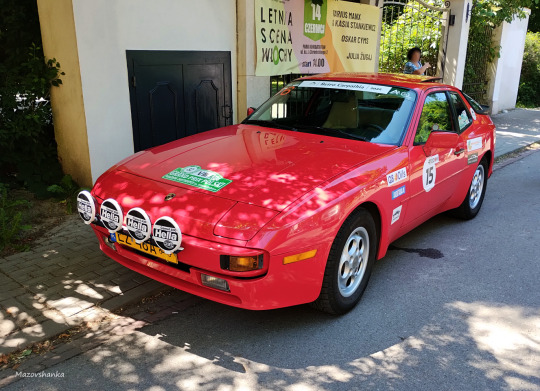



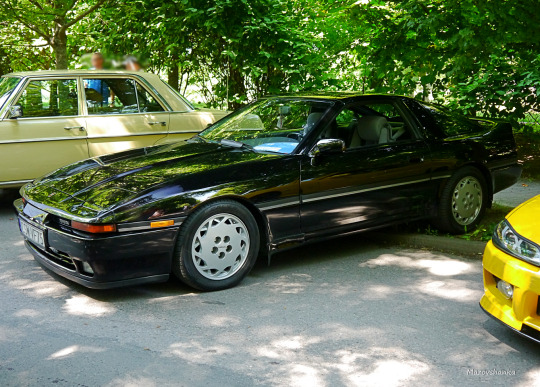
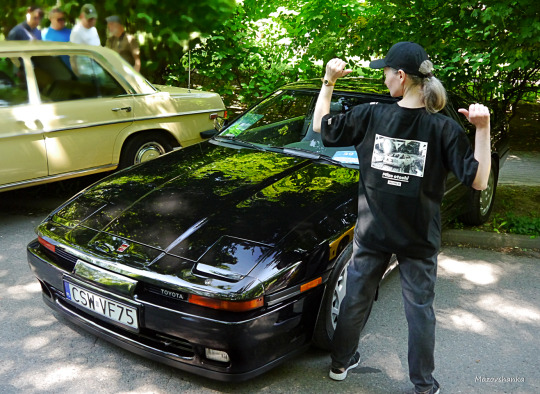



Yesterday I went to Klasyczne Nowe Włochy 2025, a classic car show in my city. There were many Italian cars, mostly Alfa Romeo and Fiat, but the one I liked the most was Toyota Supra MK3. To me it's one of the most beautiful cars. It's stylish, it's comfortable, RWD and sleepy eyes headlights - simply the best. OK, apart from Mazda RX-7 Savanna which is my no 1. And I finally managed to see Wankel engine. That was so exciting. And that blue De Tomaso Pantera was so cool too.
#warsaw#car photography#carspotting#classic cars#vintage cars#old cars#toyota supra#japanese cars#german cars#italian cars#de tomaso#pantera#porsche 944#porsche 912#alfaromeo#wankel#rotary engine#automotive
29 notes
·
View notes
Text

Types of Engine Layout
#usa#engineering#automotive#vehicle#electric vehicles#cars#classic cars#automobiles#car show#vintage cars#wankel#rotary#piston hondo#automobile#audi
16 notes
·
View notes
Text

#animated gif#animated gifs#gif#gifs#old advertisements#old ads#retro#vhs#rotary 6PI#6 port induction#10.0KM/L#130PS#PS is horsepower#more or less#engine#motor#wankel#tee hee#80s
12 notes
·
View notes
Text
I suppose the NASA Stirling engine does a bit worse than an Iron Duke engine, which is often regarded as a reliable but rather unenjoyable engine to have.
Iron Duke sounds like it should be the engine of a huge 1957 land yacht with massive chrome tailfins, not some subcompact economy car from the late 1970s through early 1990s.
It's interesting that Mazda seems to be trying (almost) the opposite approach with the MX-30, reviving the Wankel engine as its electric range extender, since Wankel engines are usually regarded as being high specific power, low efficiency. Supposedly this Wankel engine can run at an optimally efficient RPM or something?
Stirling-electric hybrid vehicles are an idea that I keep coming back to, even though this is an idea people far smarter and better at engineering than I have been trying to tackle for a very long time. (The earliest example I can think of is the GMC Stir-Lec from 1969, but it honestly wouldn’t surprise me if someone was trying to build a Stirling electric hybrid when Stanley Steamers were still battling Ford Model Ts.) All the current trends – and regulatory frameworks – are toward full electrification based on giant batteries, but Stirling-electric still captivates my imagination.
A Stirling engine has a lower power-to-weight ratio than an internal combustion engine, but how bad is it? Well, the 1986 NASA project said they had gotten it to 3.35 kg/kW. (Has there been any progress since 1986 on Stirling engines? I don’t know. There have been some new developments with thermoacoustic Stirling engines and such, but I’m not sure they’d be any better than traditional Stirling engines for this application.) With a hybrid, the most sensible approach is to make the heavy Stirling engine as weak as it can be while sustaining a desired top cruising speed – bursts of acceleration are better handled by electrical motors with better power-to-weight ratios.
It’s commonly said that a car only needs maybe 20 hp (15 kW) to cruise at a highway speed of, say, 60 mph/100 kmh. That’s not very marketable, though. If we supposed that a top sustainable speed – the top speed at which you’re burning fuel, but not draining your batteries – should be more like 90 mph, then we might want 1.5^3 = 3.375 times that much power (this is on the pessimistic assumption that air resistance is basically all resistance, since it scales worst (cubically) with speed). Other situations besides speeding, like towing or going up a long-enough upward incline that it wouldn’t just be cleared on battery alone, might also be occasions for sustained power higher than the ~15 kW highway level. So maybe 50 kW. A stirling engine capable of producing that might weigh 170 kg.
For our electric motors, we might want, say, 150 kW, for a marketably peppy response. The motor of a Tesla Model 3 (cited in Wikipedia on a list of power densities) has got 6.26 kW/kg. That might require 30 kg. If we’re going for a serial hybrid rather than a parallel hybrid – with no direct connection between the Stirling engine and the drivetrain, only a connection that bypasses the battery to feed electrical power to the motors directly – then the power going to the tires is just from the electric motors, not the Stirling engine. This might simplify the engineering, though..
Then there are the batteries. If we wanted four minutes of battery power at near-maximum power – making sure to compensate for any lag in the Stirling engine heating up – then we’d want ~100 kW * ~250 seconds = 25 MJ. This is also close to the minimum for an American tax-break eligible plug-in hybrid electric vehicle, which requires a battery of at least 7 kWh, or 25.2 MJ. If we got 0.4 MJ/kg then that’s another 65 kg. One question is whether the battery has enough power, not just enough energy. I am having a hard time finding sources on this. Wikipedia pages on power density seem too pessimistic given what we see out of electric vehicles like the Model S Plaid. (100 kWh battery, 1020 hp ~=760 kW, suggesting that a battery can discharge itself in 8 minutes at most, depending on whether the Plaid is basically designed with motors that are as powerful as possible given its battery.) We might need to double the size of the batteries to power the motors enough.
So we’re adding 265-340 kg to the vehicle so far. There will probably be a bit more – regenerative braking systems, power distributing linkages, etc. On the other hand, we’ve gotta remember that we’re also taking the internal combustion engine out.
Is 280 kg too much? I suppose a comparison might be plug-in hybrids, which are rather heavy on account of an ICE-electric hybrid energy system and a rather large battery. A Subaru Crosstrek conventional has a curb weight of 3298 lbs, while the PHEV weighs in at 3,717 lbs, a difference of 190 kg. The Kia Sportage has a curb weight of 3,373 lbs, while the PHEV version weighs 4211, a difference of 380 kg.
Perhaps with some sort of modular system could add versatility to the fueling types, with different modules for gasoline, compressed natural gas or hydrogen, waste vegetable oil (perhaps a preheater would be good for something that viscous). The Stirling engine might lose a little peak power on some fuels relative to gasoline, but for ordinary, not-too-fast, not-too-hilly cruising that might just mean it runs more and it doesn’t affect the performance too much – although in times of persistent high demand for power, like climbing up a hill, towing a trailer, or just speeding, you might notice the deficiency.
One possible issue is hydrogen embrittlement. If the Stirling engine has a working fluid other than hydrogen, it would be less efficient, while if it’s using materials that are resistant to hydrogen embrittlement, then that might make it less rugged and heavier. I think they used sufficiently embrittlement-resistant stainless steel and hydrogen as a working fluid in the 1986 NASA project, but one way to cheat for a short-term test of a relatively powerful, light Stirling engine would be to just use hydrogen as a working fluid and regular steel engine parts, and if they crack like a week later, that’s after your tests are done.
I don’t really know that much about the details of obstacles to alternative ideas for cars, though. I guess I’ve been a bit car-brained since I became a car owner almost a year ago. I suspect that when you first get a job as an engineer at Ford or Honda, the first thing in your inbox is a Powerpoint attachment titled “Here’s Why We’re Not Going to Consider Your Stupid Alternative Powertrain Ideas.” Maybe if someone could leak that to me that would give me some clarity.
I guess Dean Kamen tried to get some kind of Stirling-based car going, and there's some guy, Josh MacDowell, who turned a Ford F-150 into a Stirling-Electric hybrid? Given that there's no IP protection on Stirling engines, though, I think there must be more practical obstacles that I'm not considering.
Update: One consideration I omitted was volume. Although the batteries of battery electric vehicles are infamous for being heavy, they are convenient geometrically, being dense, mostly homogeneous, and capable of being fit in almost any shape so long as the final volume is the same.
2 notes
·
View notes
Text
Me fleshing out my slapdash magic system and the mechanisms with which revivification can be achieved:

#This is already SO much more in depth than I anticipated but that's okay#Awful lot of researching methane biogas production and learning what a wankel engine is#for something that's only going to half-use the actual science behind those things#They are fascinating tho and biogas is cool#the riddle rambles on
2 notes
·
View notes
Text






Eunos Cosmo Type E, 1990. The only series production car to be powered by a triple-rotor Wankel engine, the E (Elegant) version was the luxury flagship and was the most expensive car Mazda has ever marketed. It was also the first car to come with a built-in GPS navigation system. It remained a Japanese market only car though some have subsequently been exported. The 276hp 20B-REW engine was limited to 180 km/h (111.8 mph) to comply with Japanese regulations, but was capable of 255 km/h (158.4 mph) unrestricted.
#Eunos#Eunos Cosmo Type E#1990#triple rotor#mazda rotary#rotary engine#luxury car#turbocharged#GPS#first of its kind#Wankel engine#1990s#personal luxury car#dead brands
258 notes
·
View notes
Text
The UK government and arms industry are both complicit in Israel’s killing of seven aid workers in Gaza, including three British citizens, the Campaign Against Arms Trade (CAAT), has alleged. The workers were killed by a strike from a Hermes 450 drone manufactured by Israeli-owned company Elbit Systems. The drone is powered by a UK-made R902(W) Wankel engine, produced by Elbit subsidiary UAV Engines Limited in the UK.
Sandi, ‘UK is ‘complicit’ in Israel's killing of British aid workers in Gaza, says CAAT’, Middle East Monitor
#Middle East Monitor#Israel#Palestine#genocide#UK#Campaign Against Arms Trade#CAAT#Hermes 450#Elbit Systems#R902(W) Wankel#UAV Engines Limited#Sandi
3 notes
·
View notes
Text
Car Spot: Trabant 601 S "Delux"
A cold war relic is this week's car spot.
East Germany’s answer to West Germany’s “People’s Car” …. Growing up in the 1960s and ’70s I remember the Cold War, and how the communists used East Berlin as a showcase for the success of socialism. Automobiles were a big part of that but ultimately, they were just terrible cars like this week’s car spot, the Trabant 601 S Dulux. Found this example at the Air Force Museum in Dayton, Ohio. I…

View On WordPress
#Car Spots#car spotting#cold war#East Germany#National Museum of the USAF#savageonwheels.com#Trabant 601 S "Delux"#Wankel rotary engine
3 notes
·
View notes
Text
The REAL rotary engines
Want to really annoy a Mazda fan with a Wankel engine without whispering "apex seals" into their ear? Tell them it's not a real rotary engine.

Before the pistonless Wankel design, "rotary engine" meant something very different, where the entire engine would be spinning along with whatever it was driving. The main use for this was very early airplanes. The propeller would spin, and so would the engine! You get the benefit of increased airflow and less worry about gears, since the crankshaft is basically the airplane itself and the engine spins around it.
There aren't any reciprocating parts, and you can use a lighter construction overall. The downside: A "total loss" oil system. There's no easy way to get oil back to the middle of the engine to send it back through the cylinders, so oil must be burned along with the fuel.
The increasing scale of airplanes after the First World War lead to them quickly becoming obsolete compared to water-cooled and massive radial designs. Its last gasp was in helicopter applications, but even then there were better ways to do it.
The rotary engine had one other neat use outside of aircraft: motorcycles! A small rotary engine fit very neatly inside of the wheels, and could turn the wheel to directly drive it.

Anyways, the whole purpose of this post is vocabulary.
Rotary engine: Whole engine spins
Radial engine: Cylinders turn a crankshaft and are arranged in a circle (most common)
Wankel engine: Sets off long-winded rants about efficiency
0 notes




